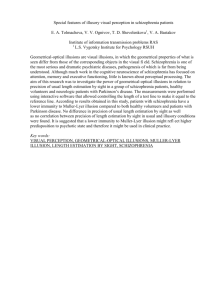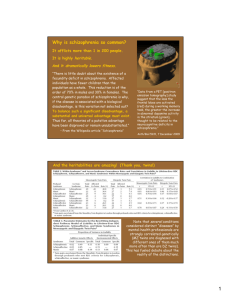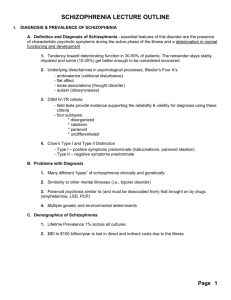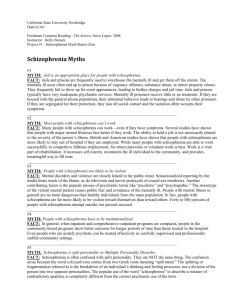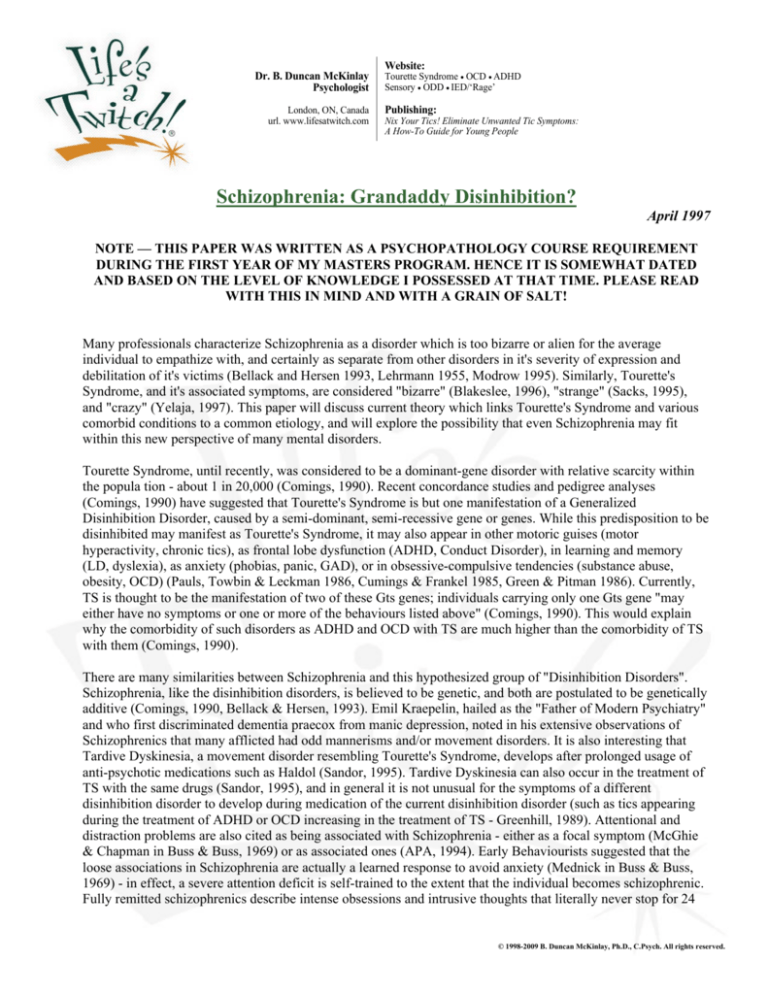
Website:
Dr. B. Duncan McKinlay
Psychologist
London, ON, Canada
url. www.lifesatwitch.com
Tourette Syndrome • OCD • ADHD
Sensory • ODD • IED/‘Rage’
Publishing:
Nix Your Tics! Eliminate Unwanted Tic Symptoms:
A How-To Guide for Young People
Schizophrenia: Grandaddy Disinhibition?
April 1997
NOTE — THIS PAPER WAS WRITTEN AS A PSYCHOPATHOLOGY COURSE REQUIREMENT
DURING THE FIRST YEAR OF MY MASTERS PROGRAM. HENCE IT IS SOMEWHAT DATED
AND BASED ON THE LEVEL OF KNOWLEDGE I POSSESSED AT THAT TIME. PLEASE READ
WITH THIS IN MIND AND WITH A GRAIN OF SALT!
Many professionals characterize Schizophrenia as a disorder which is too bizarre or alien for the average
individual to empathize with, and certainly as separate from other disorders in it's severity of expression and
debilitation of it's victims (Bellack and Hersen 1993, Lehrmann 1955, Modrow 1995). Similarly, Tourette's
Syndrome, and it's associated symptoms, are considered "bizarre" (Blakeslee, 1996), "strange" (Sacks, 1995),
and "crazy" (Yelaja, 1997). This paper will discuss current theory which links Tourette's Syndrome and various
comorbid conditions to a common etiology, and will explore the possibility that even Schizophrenia may fit
within this new perspective of many mental disorders.
Tourette Syndrome, until recently, was considered to be a dominant-gene disorder with relative scarcity within
the popula tion - about 1 in 20,000 (Comings, 1990). Recent concordance studies and pedigree analyses
(Comings, 1990) have suggested that Tourette's Syndrome is but one manifestation of a Generalized
Disinhibition Disorder, caused by a semi-dominant, semi-recessive gene or genes. While this predisposition to be
disinhibited may manifest as Tourette's Syndrome, it may also appear in other motoric guises (motor
hyperactivity, chronic tics), as frontal lobe dysfunction (ADHD, Conduct Disorder), in learning and memory
(LD, dyslexia), as anxiety (phobias, panic, GAD), or in obsessive-compulsive tendencies (substance abuse,
obesity, OCD) (Pauls, Towbin & Leckman 1986, Cumings & Frankel 1985, Green & Pitman 1986). Currently,
TS is thought to be the manifestation of two of these Gts genes; individuals carrying only one Gts gene "may
either have no symptoms or one or more of the behaviours listed above" (Comings, 1990). This would explain
why the comorbidity of such disorders as ADHD and OCD with TS are much higher than the comorbidity of TS
with them (Comings, 1990).
There are many similarities between Schizophrenia and this hypothesized group of "Disinhibition Disorders".
Schizophrenia, like the disinhibition disorders, is believed to be genetic, and both are postulated to be genetically
additive (Comings, 1990, Bellack & Hersen, 1993). Emil Kraepelin, hailed as the "Father of Modern Psychiatry"
and who first discriminated dementia praecox from manic depression, noted in his extensive observations of
Schizophrenics that many afflicted had odd mannerisms and/or movement disorders. It is also interesting that
Tardive Dyskinesia, a movement disorder resembling Tourette's Syndrome, develops after prolonged usage of
anti-psychotic medications such as Haldol (Sandor, 1995). Tardive Dyskinesia can also occur in the treatment of
TS with the same drugs (Sandor, 1995), and in general it is not unusual for the symptoms of a different
disinhibition disorder to develop during medication of the current disinhibition disorder (such as tics appearing
during the treatment of ADHD or OCD increasing in the treatment of TS - Greenhill, 1989). Attentional and
distraction problems are also cited as being associated with Schizophrenia - either as a focal symptom (McGhie
& Chapman in Buss & Buss, 1969) or as associated ones (APA, 1994). Early Behaviourists suggested that the
loose associations in Schizophrenia are actually a learned response to avoid anxiety (Mednick in Buss & Buss,
1969) - in effect, a severe attention deficit is self-trained to the extent that the individual becomes schizophrenic.
Fully remitted schizophrenics describe intense obsessions and intrusive thoughts that literally never stop for 24
© 1998-2009 B. Duncan McKinlay, Ph.D., C.Psych. All rights reserved.
Website:
Dr. B. Duncan McKinlay
Psychologist
London, ON, Canada
url. www.lifesatwitch.com
Tourette Syndrome • OCD • ADHD
Sensory • ODD • IED/‘Rage’
Publishing:
Nix Your Tics! Eliminate Unwanted Tic Symptoms:
A How-To Guide for Young People
hours a day (Modrow, 1995), and research shows that the symptoms of OCD and schizophrenia do co-occur
(Bellack & Hersen, 1993). The presence of OCD and psychotic -like symptoms oftentimes indicate the presence
of a schizotypal personality style (Bellack & Hersen, 1993), which is considered by some to be the precursor to
Schizophrenia (Meehl in Buss & Buss, 1969) and used to be the Simple subtype of Schizophrenia (Davison &
Neale, 1994).
With regards to physiology, there are many similarities between Schizophrenia and disinhibition disorders as
well. Enlarged ventricles are typical of process schizophrenics (Frith, 1992) movement disorders (Owens et. al.,
1985, in Frith, 1992), and Obsessive-Compulsive Disorder (Bellack & Hersen, 1993). The striatum (a component
of the basal ganglia) is implicated in Schizophrenia (Frith, 1995), TS (Comings, 1990), and OCD (Bellack &
Hersen, 1993). Frontal lobe dysfunction in recent years has become an area of research in Schizophrenia
(Bornstein, 1991). The frontal lobes are involved in judgment, rationality, and critical thinking, and it has been
discovered that in Schizophrenia the left frontal cortex shows much less metabolism during activity (Frith, 1995).
Left frontal underactivity has also been identified in OCD (Bellack & Hersen, 1993), and TS (Doran, 1996);
frontal "brown-out" is also a hallmark of ADHD (Doran 1996; Kronenberger & Meyer 1996). Abnormal
catecholamine levels are involved with ADHD, OCD, TS, and Schizophrenia (Comings, 1990, APA, 1994) and
dopamine specifically is discussed in Schizophrenia (Frith, 1992) and TS (Comings, 1990). In sum, it seems that
problems with the connections and communications between the striatum (whic h is influenced by dopamine
levels, and is involved in the willing and execution of movement) and the prefrontal cortex (the "goal-centers")
cause the symptoms of Schizophrenia (Frith, 1992) including the obsessional components and perseverances also
seen in TS.
The prognoses of Schizophrenia, TS, ADHD, and OCD parallel one another - all can be chronic, lifelong
conditions, or can completely remit. It is only in the past few years that ADHD in adulthood has reached wide
acknowledgment (Kronenberger & Meyer, 1996), and a portion of the TS population does remit in their early
20's (Comings, 1990). As the fundamental problem with being overly disinhibited is a high level of stimulation,
environmental stressors have a significant impact on the course of disinhibition disorders. Likewise, metaanalyses have shown that disturbed and distressing parental interactions can trigger and influence the expression
of Schizophrenia (Goldstein & Strachen in Vinogradov, 1995). The negativism and immobility in catatonic
schizophrenia that suddenly erupts into violent outbursts (Davison & Neale, 1994) is reminiscent of ADHD and
Tourettic rage when stimulation thresholds are reached (Pruitt, 1996).
Despite all of the overlap between various disinhibition disorders, and between Schizophrenia and disinhibition
disorders, there are still obvious differences. Schizophrenia is much more severe than TS, ADHD and OCD.
Onset of schizophrenia tends to be much later - early 20's for men to early 30's for women (Jablensky, 1992)
Versus four for ADHD (Kronenberger & Meyer, 1996), seven for TS (Comings, 1990), and late adolescence for
OCD (Bellack & Hersen, 1993).
How then do we conceptualize the overlap of these various conditions? Just as the various and diverse forms of
Schizophrenia are believed to be bound by the fundamental and primary feature of loosening of associations
(Bleuler, in Arieti, 1955), all of these conditions are different manifestations of the common process of disinhibition. TS can be conceptualized as a motoric disinhibition, ADHD as a disinhibition of the focusing of attention,
and OCD as a disinhibition of specific concerns, wishes, and/or cognitions. Schizophrenia, then, is a disinhibition
of thinking in a generalized sense - rather than experiencing a specific enervation or stimulation in a localized
area of the brain (a motoric centre, or particular ruminations) causing repetition and attendance to a particular
© 1998-2009 B. Duncan McKinlay, Ph.D., C.Psych. All rights reserved.
Website:
Dr. B. Duncan McKinlay
Psychologist
London, ON, Canada
url. www.lifesatwitch.com
Tourette Syndrome • OCD • ADHD
Sensory • ODD • IED/‘Rage’
Publishing:
Nix Your Tics! Eliminate Unwanted Tic Symptoms:
A How-To Guide for Young People
ritual or thought, a more generalized overstimulation occurs. The result is that ALL cognitions are in a state of
arousal. While in this heightened state, it would take little additional stimulation for each association to reach
threshold for awareness, and odd associations between unrelated cognitions would be forged due simply to the
fact that both are simultaneously aroused (Hebb, 1949). Thus the individual's attention would bound from
Association to association, no matter how tangentially related; while a normally inhibited individual can remain
coherent and "on-track" because the next logical associative thought is stimulated to a greater degree than
distantly related associations, this differential is lost in individuals with Schizophrenia.
Illustratively, imagine walking a dog through a cat-show on a leash. The dog very much wants to "associate"
with ALL of these various felines, however it will remain to "associate" with it's master, as the leash's strength is
stronger than the allure of the cats. Thus the dog will continue on a progressive and planned course throughout
the cat-show with its master. What if suddenly the leash is cut (i.e., the differential strengths of associations is
eliminated)? Of course the dog will tear off hysterically after the first cat it sees, and if another, closer cat catches
it's attention it will abruptly shift course and aim for the new target, until another grabs it's eye, and another, and
another. Obviously the result is chaos.
Frith (1992) postulated a model of Schizophrenia in which symptoms are the result of a failure to self-monitor.
Positive symptoms (i.e. hallucinations and delusions) occur when a willed action is carried out by the basal
ganglia, but the latter fails to send a feedback message to the perceptual center. In other words, an individual will
"self-talk" or initiate a movement but will not be AWARE that (s)he is/did. Hallucinations are the interpretations
of "self-talk" in the absence of self-awareness, and delusions (such as delusions of control) are the interpretations
of movements without the knowledge that (s)he planned them (Frith, 1992). Negative symptoms are considered
to be even heavier damage to communications between the cortex, basal ganglia, and the perceptual centers wills are no longer able to generate intentions to act at all.
This theory requires only slight modification to fit the disinhibition model. Positive symptoms will be addressed
first. Assuming that the basal ganglia is designed to deliver a "normal" number of feedback messages to the
perceptual system, in a state of generalized disinhibition (overstimulation), it may be that the system either
"shorts out", or continues to work but "misses" some messages. These "missed" messages are then the ones
attributed as hallucinations and delusions. Frisk (1992) also suggested that positive symptoms could be the result
of stimulus-driven actions (afforded actions) that are not inhibited by one's goals (communication problems
between the prefrontal cortex and the striatum). This is more or less synonymous with the definition of TS.
With regards to negative symptoms, under a state of extreme stimulation one is less likely to initiate actions at
all - despite a will to involve oneself in life in various ways, overstimulation deters one from developing an
intention. Recall Hans Eysenck's theory on introversion-extroversion: introverts do not need to seek sensation (or
initiate actions) to the same degree as do extroverts, as their internal stimulation is already high (Day, 1992).
Individuals with disinhibition disorders (ex. TS) sometimes will avoid social contact in an attempt to minimize
stimulation levels.
Modifying Frith's (1992) theories of schizophrenia so that they are framed within the context of disinhibition
helps to explain certain facts that were inconsistent with Frith's original conceptions. First, there is considerable
research that suggests that even the most severely debilitated of schizophrenics can recover - some undergo
complete remission (Modrow, 1995). If there were actual structural lesions in schizophrenia this would not be
possible (although it is certainly possible that after years of overstimulation certain irreversible structural
© 1998-2009 B. Duncan McKinlay, Ph.D., C.Psych. All rights reserved.
Website:
Dr. B. Duncan McKinlay
Psychologist
London, ON, Canada
url. www.lifesatwitch.com
Tourette Syndrome • OCD • ADHD
Sensory • ODD • IED/‘Rage’
Publishing:
Nix Your Tics! Eliminate Unwanted Tic Symptoms:
A How-To Guide for Young People
damages could occur, thus rendering the condition permanent). There have also been reports of professionals
being treated after-hours for schizophrenia, and incidents where seemingly completely debilitated schizophrenics
have somehow "suppressed" their symptoms long enough to operate normally for some time before returning to
their debilitated state (Modrow, 1995). Hyperfocusing in ADHD (Doran, 1996) and temporary suppression of
tics in TS (Comings, 1990) are well-documented and analogous phenomena.
Second, if there were actual mechanical problems with the relay of messages why do dopamine-blocking drugs
completely eliminate hallucinations and delusions? Frith (1992) suggested that dopamine-blockers operate
indirectly; by tranquilizing the individual globally, one reduces the number of movements that could be
misattributed to hallucinations and delusions because one reduces the overall number of movements. With a
structural-problem hypothesis, one would REDUCE hallucinations and delusions, but as long as the individual
made ANY movement hallucinations and delusions would still exist. Within the disinhibition model, however,
this inconsistency is eliminated - by reducing the amount of stimulation, and hence number of messages,
impinging on the basal ganglia to "normal" levels, the system is no longer overtaxed, it resumes "normal"
activity, and no messages are "missed" (and misattributed) anymore.
Finally, it is difficult to explain how stimulants can mimic Schizophrenia if structural problems are definitive of
the disorder (as in Amphetamine Psychosis - APA, 1994), but it makes perfect sense within a disinhibition
model - in "natural" schizophrenics, overstimulation is caused by disinhibition. In "amphetamine" schizophrenics
the overstimulation is artificial. Regardless of the locus of the overstimulation, the effects are the same.
In sum, Frith's (1992) theory that schizophrenic symptoms are caused by a problem in self-monitoring seems
valid. It is interesting to note that one popular method of treating individuals with TS is to explicitly teach selfmonitoring strategies (Kronenberger & Meyer, 1996). Frith's reasons for the self-monitoring problems were
questioned, however; the hypothesis that self-monitoring difficulties are the result of overstimulation due to
disinhibition seems to fit the known facts better than the hypothesis that there is actual structural damage to the
brain (Frith, 1992).
If Schizophrenia IS to be considered as a disinhibition disorder, it is obviously the most debilitating and severe of
them all. While the predominant feature of Schizophrenia has been outlined to be the disinhibition of general
thought associations, it seems to have characteristics of many other disinhibition disorders such as ADHD, TS,
and OCD (as described earlier). The idea that genes could work additively was previously mentioned - it may be
that, just as TS is considered by some to be "ADHD + tics" (Doran, 1996), Schizophrenia is "ADHD, OCD, TS,
etc. + thought disinhibitions". Genetic heterogeneity (Bellack & Hersen, 1993) is the current genetic theory of
Schizophrenia - it suggests that while there is an additive genetic component to Schizophrenia, there are one or
two dominant Schizophrenia genes which are necessary and sufficient for the disorder (Bellack & Hersen, 1993).
Perhaps there does exist a particular gene that causes the disinhibition of thought, and these "additive genes" are
other disinhibition, or Gts, genes. It does not seem unreasonable to suspect that many genes exist whose
functions involve a wide range of disinhibitory functions - disinhibition in general is essential to survival in order
to manipulate the environment, and certain disinhibitio ns (for example, sexual) have been postulated to have
particular adaptive advantage (Comings, 1990). Considering that the human cortex has evolved to be inhibitory,
the need for SOMETHING to cause disinhibition is of course essential.
After having developed dimensions of disinhibition, the next theoretical step in such a discussion seems to be to
discuss spectrums of disinhibition. Are all of these different disinhibition disorders, including Schizophrenia,
© 1998-2009 B. Duncan McKinlay, Ph.D., C.Psych. All rights reserved.
Website:
Dr. B. Duncan McKinlay
Psychologist
London, ON, Canada
url. www.lifesatwitch.com
Tourette Syndrome • OCD • ADHD
Sensory • ODD • IED/‘Rage’
Publishing:
Nix Your Tics! Eliminate Unwanted Tic Symptoms:
A How-To Guide for Young People
merely different manifestations of the same amount of overstimulation, or are some disorders characterized by
more disinhibition than others? One might tentatively postulate a spectrum such as:
Extrovert -- Introvert -- ADHD -- TS/OCD -- Reactive Sx -- Process Sx
This spectrum would seem to apply not only to degree of internal disinhibition, but also to age of onset [Infants
as young as 22 months can be categorized by temperament (Plomin & Rowe 1979 in Day, 1992)], and prognosis.
In conclusion, the evidence supporting the consideration of Schizophrenia as a disinhibition disorder seems
persuasive and plentiful. Current neurophysiological models of Schizophrenia can be modified to reflect
overstimulation of thought associations as the fundamental cause of both positive and negative symptoms; in this
altered form these models can account for more findings in the literature than they could without incorporating
the idea of disinhibition. Schizophrenia may fit on a spectrum of disinhibition, in which it is the accumulation of
an assortment of other disinhibition disorders and, thus, the most severe of all subtypes.
References
American Psychiatric Association (1994). Diagnostic and Statistical Manual of Mental Disorders. Washington,
D.C.: American Psychiatric Association.
Arieti, Silvano (1955). Interpretation of Schizophrenia. New York: Robert Brunner.
Bellack, Alan S., and Michel Hersen (1993). Psychopathology in Adulthood. Toronto: Allyn and Bacon.
Blakeslee, Sandra (1996). Faulty neurological brakes may cause Tourette's tics. The Globe and Mail, Sept. 21.
Bornstein, R.A. (1991). Neuropsychological correlates of obsessive characteristics in Tourette Syndrome.
Journal of Neuropsychiatry, 3, pgs. 157-162.
Buss, Arnold H. and Edith H. Buss (eds.) (1969). Theories of Schizophrenia. New York: Atherton Press.
Comings, David E. (1990). Tourette Syndrome and Human Behaviour. California: Hope Press.
Cumings, JL, and Frankel, M. (1985). Gilles de la Tourette syndrome and the neurological basis of obsessions
and compulsions. Biological Psychology, 20, pgs. 1117-1126.
Davison, Gerald C., and John M. Neale. Abnormal Psychology. 6th ed. Toronto: John Wiley & Sons, Inc.
Day, Richard B. (1992). Theories of Personality Student Handbook. Massachusetts: Ginn Press.
Diamond, M.C., Scheibel, A.B., and L.M. Elson (1985). The Human Brain Coloring Book. New York: HarperCollins Inc.
© 1998-2009 B. Duncan McKinlay, Ph.D., C.Psych. All rights reserved.
Website:
Dr. B. Duncan McKinlay
Psychologist
London, ON, Canada
url. www.lifesatwitch.com
Tourette Syndrome • OCD • ADHD
Sensory • ODD • IED/‘Rage’
Publishing:
Nix Your Tics! Eliminate Unwanted Tic Symptoms:
A How-To Guide for Young People
Doran, Mort (August 1996). Tourette Syndrome Presentation. Chedoke-McMaster Hospital, Hamilton, ON.
Doran, Mort (Jan. 23, 1997). Tourette Syndrome Presentation. Kitchener-Waterloo Board of Education,
Kitchener-Waterloo, ON.
Frith, Christopher D. (1992). The Cognitive Neuropsychology of Schizophrenia. Hillsdale: Lawrence Erlbaum
Associates.
Kronenberger, William G., and Robert G. Meyer (1996). The Child Clinician's Handbook. Toronto: Allyn and
Bacon.
Green, RC, and Pitman, RK (1986). Tourette Syndrome and obsessive-compulsive disorder, in ObsessiveCompulsive Disorders: Therapy and Management. Edited by Jenike, MA et. al. PSG, pgs. 147-164.
Greenhill, L.L. (1989). Pharmacologic treatment of Attention Deficit Hyperactivity Disorder. Pediatric
Psy-chopharmacology, 15, pgs. 1-27.
Hebb, DO (1949). The organization of behavior. New York: Wiley.
Jablensky, A. et. al. (1992). Schizophrenia: manifestations, incidence and course in different cultures A World
Health Organization ten-country study. Psychological Medicine (Monograph Supplement 20). New York:
Cambridge University Press.
Lehrmann, Heinz (1955). National Film Board: Series on Schizophrenia.
Modrow, John (1995). How To Become A Schizophrenic The Case Against Biological Psychiatry. 2nd ed.
Washington: Apollyon Press.
Owens, D.G.C., Johnstone, E.C., Crow, T.J., et. al. (1985). Lateral ventricle size in schizophrenia: relation to the
disease process and its clinical manifestations. Psychological Medicine, 15, pgs. 27-41.
Pauls, DL, Towbin, KE, Leckman, JF, et. al. (1986) Gilles de la Tourette syndrome and obsessive compulsive
disorder: evidence supporting an etiological relationship. Archive of General Psychology, 43, pgs. 1180-1182.
Pruitt, Sheryl K (1996). Teacher's Workshop on Tourette syndrome, Obsessive-Compulsive Disorder, and
Attention Deficit Hyperactivity Disorder. Toronto, ON.
Sacks, Oliver (1995). The surgeon who ticced. The Globe and Mail. March 4.
Sandor, P. (1995). Clinical management of Tourette's syndrome and associated disorders. Canadian Journal of
Psychiatry, 40, pgs. 577-583.
Vinogradov, Sophia and Irvin D. Yalom (eds.) (1995). Treating Schizophrenia. San Francisco: Jossey-Bass
Publishers.
Yelaja, Priti (1997). Tourette torment. The Record. Jan. 24.
© 1998-2009 B. Duncan McKinlay, Ph.D., C.Psych. All rights reserved.




